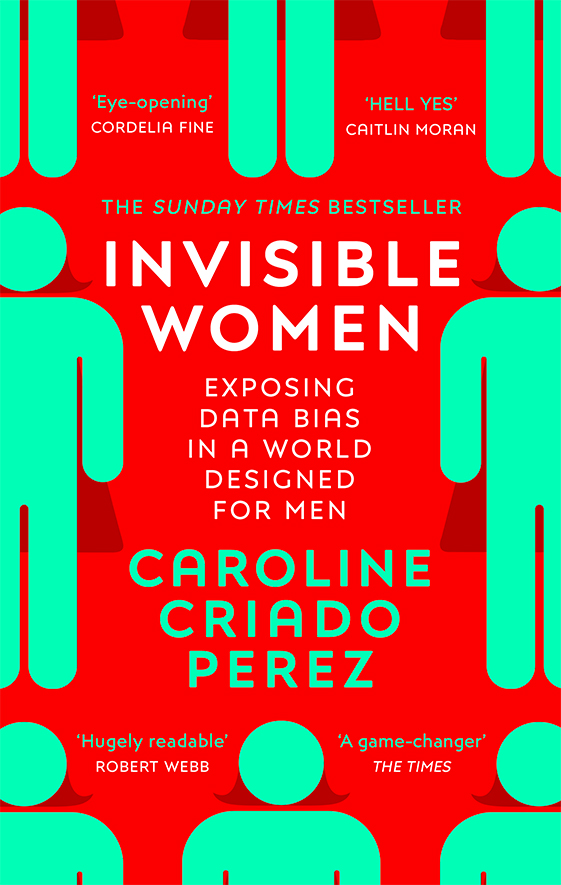What do toilets, snow ploughing, car crash dummies, the size of our phones, artwork, and healthcare all have in common? How are they related to gender equality, or rather, gender inequality? Well, let me tell you: They’ve all been influenced by and promotes gender inequality, because of a lack in data and a bias in society’s structure and design. Whether we like it or not, over the centuries the world has been designed predominantly by men for men, more precisely by white men for white men, and we all experience the impact from that daily.
If you haven’t read the book Invisible Women: Exposing Data Bias in a World Designed for Men, you really should. It shows how data impacts inequality and how almost every aspect of society is based on a male default. Many of the facts mentioned in the book aren’t news to most of us. Payment gap, more unpaid labor, and higher risk of assault are just three of the issues we are all well aware of, but can’t seem to change. Let’s break down some of them:
We all know the annoyingly long queues in front of female bathrooms. For some reasons male bathrooms never seem to have a queue. Well, the reasons are known. Both bathrooms usually have the same floor space. Yet, if you take into account that male bathrooms have urinals alongside the regular bathroom stalls, the number of people who can relieve themselves is a lot higher if you break it down to usable square feet. This everyday design equally distributes floor space, but equality does not necessarily mean equity. In addition to the space itself, women take up to 2.3 times longer because many of them will have to change a sanitary pad or tampon. Some might be pregnant, causing them to have to use bathrooms more frequently and women are more likely to be accompanied by children, elderly people or people with disabilities.
Usually, a woman’s hand is smaller than a man’s hand. The average smartphone size (around 5.5 inches in length) was designed to fit a man’s hand and is too big for most women. And don’t get me started on phones (or anything else for that matter) fitting into pants pockets. Generally, women’s metabolisms are slower than men’s. The formula determining standard office temperatures was developed in the 60s and is based on the metabolic rate of a 70kg 40-year-old man, leaving the temperature 5 degrees too cold for women on average.
In order to have your art shown in the best museums and galleries in the world artists have to meet certain criteria. The problem is, that throughout history many female artists did not receive the credit for their work and their art was either ignored or claimed by other men. This is true for painters but also for musicians and composers. This has led to a disproportionally display of male artists while female artists are underrepresented simply because society has always been biased against them.
As it turns out, taking gender issues into account can save money as well. In Sweden, roads used to be cleaned of snow before pavements as the data determining where to snow plough first prioritized car commuters over pedestrians. While things have changed, more women use the pavements (e.g. taking a walk with a baby buggy and doing grocery shopping) while more men take cars. According to different studies, this led to more injuries in Sweden and 70% of the injured people were women. Simply changing the order of snow ploughing saved money in healthcare, saved people’s time and certainly helped women.
In addition to the the general data bias against women, let’s not forget about how sexuality, race, and disabilities further increase this harmful gap. We all know about many of these inequalities, but some have always been a bit too abstract to actually think about them or see them as our problem. Having them listed with factual data and thus getting a quantifiable number makes it a lot more real and with that, a lot more frustrating.

Women are 47% more likely to be seriously injured and 17% more likely to die in car crashes because the crash test dummies have always been built around the “average male body,” not taking into account physical differences like height and weight. Only in recent years have carmakers started to use different dummies based on a “typical female body” which leads to a bunch of new questions, like what exactly is a typical body in the first place?
Women are much more likely to get the wrong amount of medication which can lead to drastic consequences including death. That’s because most medicine has been tested on a male target group in the past, supposedly because hormonal changes in women during the month would have too much of an influence on the tests and their results. Shouldn’t medication take into account all people and not just leave out 50% of the population simply because they get their periods and ovulate? On the topic of health, women are also less likely to be diagnosed with having a heart attack with potential fatal results because symptoms are different for women and they are not part of the standard study material on heart attacks in med school.
Who is responsible?
Invisible Women showcases the effect of missing data on inequality and simultaneously presents dozens of reasons why we need feminism and a fight for more equality around the globe. It won’t just have benefits for individuals or small groups of people, it will also be great for the economy, so shouldn’t everyone be on board? While reading the book it becomes clear that there is still such a long way to go. It’s very sobering because you also realize that many of these issues are well-known but it seems that too many people still don’t care or believe it’s not their problem. If we want long-lasting change it’s not enough to restructure a city and redesign certain spaces to make them more equal. There needs to be a shift in thinking and behavior. We can put as many additional streetlights on a road to make it more safe for women, but we must put more effort into preventing sexual assault right from the source, meaning teach men (and women) to be better and change their mindset. Everyone is responsible for creating a save and equal world. It can’t just be pushed onto one-half of the population to figure it out by themselves. We need to work together.
If you are impacted by the data gap and data bias (and trust me, you are), it’s a must-read book. If you want more information on the author and the book itself, you can visit the website.
Get more like this—Sign up for our daily inspirational newsletter for exclusive content!
__
Photo: Gemma Chua-Tran via Unsplash; Caroline Criado Perez





